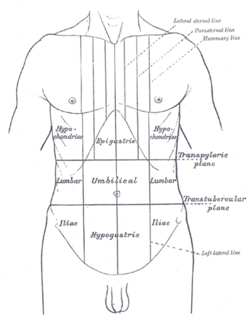| Hypochondrium | |
|---|---|
 Thorax and abdomen. Thorax and abdomen. | |
 Front of abdomen, showing surface markings for liver, stomach, and great intestine. Front of abdomen, showing surface markings for liver, stomach, and great intestine. | |
| Details | |
| Identifiers | |
| Latin | regio hypochondriaca |
| TA98 | A01.2.04.002 |
| TA2 | 256 |
| FMA | 20390 |
| Anatomical terminology[edit on Wikidata] | |
In anatomy, the division of the abdomen into regions can employ a nine-region scheme. The hypochondrium refers to the two hypochondriac regions in the upper third of the abdomen; the left hypochondrium and right hypochondrium. They are located on the lateral sides of the abdominal wall respectively, inferior to (below) the thoracic cage, being separated by the epigastrium.
The liver is in the right hypochondrium, extending through the epigastrium and reaching the left hypochondrium. The spleen and some of the stomach are in the left hypochondrium.
Definitions, etymology, and modern controversies
The word derives from the Greek word υποχόνδριο ("hypochondrio"). This Greek word means literally "below the cartilage" which refers to the costal cartilages. In other words, the word refers to the area of the ventral trunk that is located below the costal cartilages. The word once referred only to the soft portion of the abdomen between the rib cage and the navel (the region once believed to be the seat of hypochondriasis), but it is not used that way in modern anatomy's schemes for the regions of the abdomen.
Some sources have disputed usage of the term for the parts of the anterior abdominal wall below the costal margins. The region named the right hypochondrium exists anatomically, but is almost totally under the chest wall. In clinical situations, the parts of the abdominal wall just below the right and left costal margins are referred to as the right and left hypochondriac regions respectively.
Significance of region
Clinically speaking, symptoms and signs arising from this region are of great importance and have a specific list of diseases in their differential diagnoses.
Additional images
See also
References
- ^ Standring S (2016). Gray's anatomy : the anatomical basis of clinical practice (Forty-first ed.). . ISBN 9780702052309. OCLC 920806541.
{{cite book}}: CS1 maint: location missing publisher (link) - thefreedictionary.com
- Moore KL, Dalley AF, Agur AM (2013-02-13). Clinically oriented anatomy (Seventh ed.). Philadelphia. ISBN 978-1451119459. OCLC 813301028.
{{cite book}}: CS1 maint: location missing publisher (link) - "Definition of HYPOCHONDRIAC". www.merriam-webster.com. Retrieved 2019-09-26.
- Bound F (January 2006). "Hypochondria". Lancet. 367 (9505): 105. doi:10.1016/S0140-6736(06)67948-8. PMID 16413863. S2CID 208816963.
- Cirocchi R, Boselli C, Renzi C, Corsi A, Cagini L, Boccolini A, et al. (June 2014). "The surface landmarks of the abdominal wall: a plea for standardization". Archives of Medical Science. 10 (3): 566–9. doi:10.5114/aoms.2014.43749. PMC 4107261. PMID 25097589.
- Nordt SP, Bowns C, Moran J, Kelleher HB, Swadron S (December 2012). "Left upper quadrant abdominal pain". The Western Journal of Emergency Medicine. 13 (6): 495–6. doi:10.5811/westjem.2012.1.11737. PMC 3555578. PMID 23359837.
- Joshi G, Crawford KA, Hanna TN, Herr KD, Dahiya N, Menias CO (2018-05-01). "US of Right Upper Quadrant Pain in the Emergency Department: Diagnosing beyond Gallbladder and Biliary Disease". Radiographics. 38 (3): 766–793. doi:10.1148/rg.2018170149. PMID 29757718.
External links
- Abdominal Viscera Basics - Page 1 of 10 anatomy module at med.umich.edu
| Human surface anatomy and general regions | |||||
|---|---|---|---|---|---|
| Head | |||||
| Neck |
| ||||
| Thorax | |||||
| Arm | |||||
| Abdomen/pelvis |
| ||||
| Perineal | |||||
| Leg | |||||
